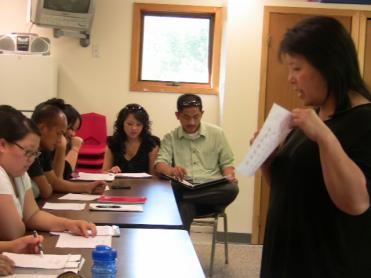






Continued growth in the Madison-area Hmong population has resulted in an increased demand for Hmong language learning opportunities. To meet the growing need for Hmong education, community initiatives like Mai Zong Vue’s free Hmong Literacy classes at Kennedy Heights Community Center, have answered the call.
Vue teaches two classes every week; one on Tuesday evenings for youth, and one on Wednesday nights for adults. Her students range in age from seven years old to those who are in their early thirties.
“Teaching Hmong is important for me to do because I see 
Vue, an administrator at the Wisconsin Department of Children and Families, has been an active member in the Madison community for over eighteen years.
She begins every course by asking her students to share their reasons for wanting to learn Hmong.
Sarah and Anthony Pha, a couple in their early thirties, decided to take Vue’s class together after Sarah saw a friend post about the course on Facebook.
“I don’t know how to read Hmong,” said Sarah Pha, a WPS Insurance Representative. “We’ve been in the United States for over thirty years…Some [Hmong] words, I don’t even know.”
Her husband, Anthony Pha, a student at ITT Technical Institute and Specialist at the Wisconsin Department of Transportation, wants to use his new skills to help the Hmong community by translating community announcements into Hmong for those who are not as fluent in English.
“I found out about this class from my wife and her friend and thought, well, it’s a good learning opportunity… I wanted to learn how to write and how to read in Hmong,” he said.
For most of the students in Vue’s class, all of whom are Hmong, learning to read and write in Hmong is a way to retain their cultural heritage and bridge the communication gap between their elders and themselves.
“My dad, he always texts [my friend and I] in Hmong and we never understand what he’s saying…So we would pass [the phone] back and forth between us, trying to figure out what he’s saying,” Sarah said.
Yer Vang, a paralegal in Madison, is taking the class for similar reasons, but is also looking for "professional development,” hoping that literacy in Hmong will make her a more attractive candidate when applying for jobs.
Hmong is one of the hardest languages to learn because it is tonal, so the meaning of a word changes depending on the final pitch. There are also multiple dialects--the most popular of which are Blue Hmong and White Hmong (the colors are a reference to the colors on the clothing associated with each group). The written form of the Hmong language follows the Romanized Popular Alphabet model and was first written down in the mid 1900s.
Throughout the summer, Vue's students will learn to read the Hmong alphabet and discern tones.
“It’s good to do it in increments to learn the fundamentals; the next step will be to develop their writing skills,” said Vue.
Currently, Vue only teaches at Kennedy Heights, but said she would be willing to start teaching another course closer to the West Side if there is enough interest.
|
|
|
Welcome to the Madison Commons, a website designed to provide news and information about all of Madison's neighborhoods and a crossroads for the discussion of community issues. The name comes from the idea of a village commons, a place for news, talk, debate, and some entertainment, too, that's open to everyone.
All rights reserved. Read more about the Madison Commons and its partners.

